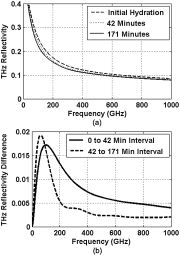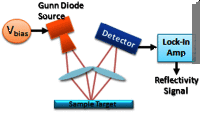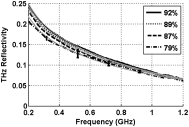Assessment of corneal hydration sensing in the terahertz band: in vivo results at 100 GHz
- PMID: 23085925
- PMCID: PMC3449294
- DOI: 10.1117/1.JBO.17.9.097008
Assessment of corneal hydration sensing in the terahertz band: in vivo results at 100 GHz
Abstract
Terahertz corneal hydration sensing has shown promise in ophthalmology applications and was recently shown to be capable of detecting water concentration changes of about two parts in a thousand in ex vivo corneal tissues. This technology may be effective in patient monitoring during refractive surgery and for early diagnosis and treatment monitoring in diseases of the cornea. In this work, Fuchs dystrophy, cornea transplant rejection, and keratoconus are discussed, and a hydration sensitivity of about one part in a hundred is predicted to be needed to successfully distinguish between diseased and healthy tissues in these applications. Stratified models of corneal tissue reflectivity are developed and validated using ex vivo spectroscopy of harvested porcine corneas that are hydrated using polyethylene glycol solutions. Simulation of the cornea's depth-dependent hydration profile, from 0.01 to 100 THz, identifies a peak in intrinsic reflectivity contrast for sensing at 100 GHz. A 100 GHz hydration sensing system is evaluated alongside the current standard ultrasound pachymetry technique to measure corneal hydration in vivo in four rabbits. A hydration sensitivity, of three parts per thousand or better, was measured in all four rabbits under study. This work presents the first in vivo demonstration of remote corneal hydration sensing.
Figures







References
-
- Mittleman D., “Terahertz imaging,” Springer Ser. Opt. Sci. 86, 117 (2002).SSOSDB
Publication types
MeSH terms
Substances
LinkOut - more resources
Full Text Sources
Other Literature Sources

